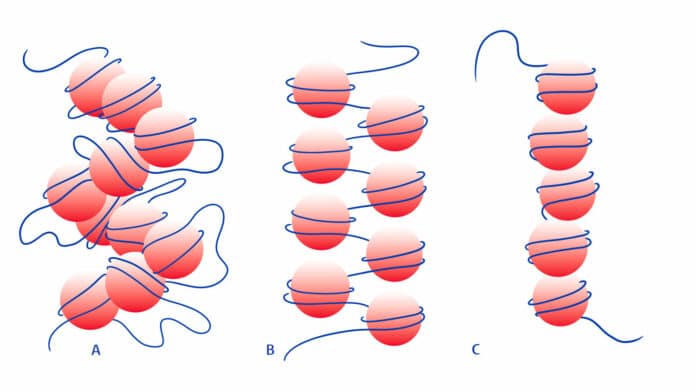Telomeres are sometimes seen as the key to living longer. They protect genes from damage but get shorter each time a cell divides. Each time a cell divides, the telomeres become slightly shorter. Eventually, they become so short that the cell can no longer divide successfully, and the cell dies.
Little is known about the structure of telomeric chromatin at the molecular level. In a new study, scientists from the Leiden Institute of Physics (LION) have discovered a new structure of telomeric DNA. They used methods from physics for biological experiments and a minuscule magnet for the discovery.
Since the DNA between the telomeres is two meters long, it must be folded to fit within a cell. This is done by wrapping packets of proteins and DNA together to form a structure known as a nucleosome. A nucleosome, a fragment of free (or unbound) DNA, a nucleosome, and so on are arranged in a pattern like a string of beads.
The bead string then contracts even further. The length of the DNA between the nucleosomes—the beads on the string—determines how it achieves this. There were already two known post-folding structures. One of them has free DNA hanging in the space between two nearby beads that cling together (fig. 2A). The nearby beads fail to bind together if the DNA gap between them is too small. Then two stacks start to form side by side.
In this study, scientists found another telomere structure: The nucleosomes are much closer together, so there is no longer any free DNA between the beads. This ultimately creates one big helix, or spiral, of DNA.
Scientists discovered this new Structure using a combination of electron microscopy and molecular force spectroscopy. The latter technique comes from Van Noort’s lab. Here, one DNA end is attached to a glass slide, and a tiny magnetic ball is stuck to the other.
A set of strong magnets above this ball then pull the string of pearls apart. By measuring the amount of force needed to pull the beads apart one by one, you find out more about how the string is folded. The researchers in Singapore then used an electron microscope to understand the structure better.
Van Noort said, “Structure is ‘the holy grail of molecular biology. Knowing the Structure of the molecules will give us more insight into how genes are switched on and off and how enzymes in cells deal with telomeres: how they repair and copy DNA, for example. The discovery of the new telomeric Structure will improve our understanding of the building blocks in the body. And that, in turn, will ultimately help us study aging and diseases such as cancer and develop drugs to fight them.”
Journal Reference:
- Soman, A., Wong, S.Y., Korolev, N., et al. Columnar Structure of human telomeric chromatin. Nature (2022). DOI: 10.1038/s41586-022-05236-5
